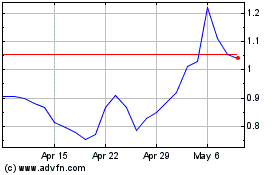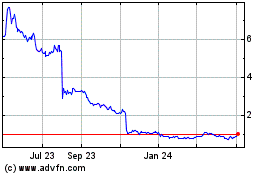Assertio Holdings, Inc. (“Assertio” or the “Company”) (Nasdaq:
ASRT), a specialty pharmaceutical company offering differentiated
products to patients, today announced that it has provided the LGS
Foundation a $100,000 educational grant to assist in efforts to
raise awareness of LGS and provide educational materials to the LGS
community.
In October, Assertio acquired an exclusive license for
SYMPAZAN® (clobazam) oral film CIV, which is approved by the
U.S. Food and Drug Administration (FDA) for the adjunctive
treatment of seizures associated with LGS in patients two years of
age or older.
According to the LGS Foundation, Lennox-Gastaut Syndrome or LGS
is a severe epilepsy syndrome. LGS is a rare disease, about 50,000
people in the United States have LGS. It is generally diagnosed
between the ages of 3 and 5, but some people aren’t correctly
diagnosed until much later. People with LGS may have many different
types of seizures, and the condition can be complex to manage. Some
people with LGS also experience cognitive and behavioral
challenges.
“Assertio is dedicated to being a great partner to the LGS
community,” said Dan Peisert, President and Chief Executive Officer
of Assertio. “We are very excited to be working with the LGS
Foundation to help fund efforts to raise awareness of LGS and to
provide educational materials that can benefit LGS patients and
their families, friends, caregivers and healthcare providers.”
“Oral film delivery is a beneficial way to deliver medication
with consistent dosing,” said Peisert. “These benefits may be
particularly important for the delivery of medications to patients
diagnosed with LGS who may have difficulty swallowing intact oral
dosage forms. In such cases, common methods such as mixing into
foods may result in administration challenges. However, we believe
that many in the LGS community may not know about SYMPAZAN’s simple
and proven effective oral film delivery option for clobazam. We
want to ensure that the LGS community is fully aware of their
available options so they can have important conversations with
their healthcare providers.”
Tracy Dixon-Salazar, Ph.D, Executive Director of the LGS
Foundation, said, “We are thrilled to be partnering with Assertio
to support our organization’s mission and to help create important
new materials for the LGS community. We look forward to a long and
collaborative partnership.”
In addition to supporting the LGS Foundation’s educational
mission, Assertio will also be joining the organization’s Corporate
Advisory Council.
About LGS FoundationThe Lennox-Gastaut Syndrome
(LGS) Foundation is a nonprofit organization dedicated to improving
the lives of individuals impacted by LGS through advancing
research, awareness, education, and family support. For more
information, please visit www.lgsfoundation.org
About SympazanSYMPAZAN is the first and only
FDA-approved oral film formulation of clobazam, a benzodiazepine
approved for adjunctive treatment of seizures associated with
Lennox-Gastaut syndrome (LGS) in patients 2 years of age or older.
SYMPAZAN oral film is berry flavored and offered in 5 mg, 10 mg,
and 20 mg dosages to meet a range of LGS patient and caregiver
needs.
About Assertio Assertio is a specialty
pharmaceutical company offering differentiated products to patients
utilizing a non-personal promotional model. We have built and
continue to build our commercial portfolio by identifying new
opportunities within our existing products as well as acquisitions
or licensing of additional approved products. To learn more about
Assertio, visit www.assertiotx.com.
INDICATIONS AND USAGESYMPAZAN® is indicated for
the adjunctive treatment of seizures associated with Lennox-Gastaut
Syndrome (LGS) in patients 2 years of age or older.
IMPORTANT SAFETY INFORMATION for Sympazan
WARNING: RISKS
FROM CONCOMITANT USE WITH OPIOIDS; ABUSE, MISUSE, AND ADDICTION;
and DEPENDENCE AND WITHDRAWAL REACTIONS
• Concomitant use of
benzodiazepines and opioids may result in profound sedation,
respiratory depression, coma, and death. Reserve concomitant
prescribing of these drugs for patients for whom alternative
treatment options are inadequate. Limit dosages and durations to
the minimum required. Follow patients for signs and symptoms of
respiratory depression and sedation. • The use of
benzodiazepines, including SYMPAZAN, exposes users to risks of
abuse, misuse, and addiction, which can lead to overdose or death.
Before prescribing SYMPAZAN and throughout treatment, assess each
patient’s risk for abuse, misuse, and addiction. •
Abrupt discontinuation or rapid dosage reduction of
SYMPAZAN after continued use may precipitate acute withdrawal
reactions, which can be life-threatening. To reduce the risk of
withdrawal reactions, use a gradual taper to discontinue
SYMPAZAN.
CONTRAINDICATIONS
SYMPAZAN is contraindicated in patients with a history of
hypersensitivity to the drug or its ingredients.
WARNINGS AND PRECAUTIONS
Risks from Concomitant Use with
OpioidsObservational studies have demonstrated that
concomitant use of opioid analgesics and benzodiazepines increases
the risk of drug-related mortality compared to use of opioids
alone. If a decision is made to prescribe SYMPAZAN concomitantly
with opioids, prescribe the lowest effective dosages and minimum
durations of concomitant use. Advise both patients and caregivers
about the risks of respiratory depression and sedation when
SYMPAZAN is used with opioids.
Abuse, Misuse, and AddictionAbuse and misuse of
benzodiazepines often (but not always) involves the use of doses
greater than the maximum recommended dosage and commonly involves
concomitant use of other medications, alcohol, and/or illicit
substances, which is associated with an increased frequency of
serious adverse outcomes, including respiratory depression,
overdose, or death.
Use of SYMPAZAN, particularly in patients at elevated risk,
necessitates counseling about the risks and proper use of SYMPAZAN
along with monitoring for signs and symptoms of abuse, misuse, and
addiction. Prescribe the lowest effective dosage; avoid or minimize
concomitant use of Central Nervous System (CNS) depressants and
other substances associated with abuse, misuse, and addiction
(e.g., opioid analgesics, stimulants); and advise patients on the
proper disposal of unused drug. If a substance use disorder is
suspected, evaluate the patient and institute (or refer them for)
early treatment, as appropriate.
Dependence and Withdrawal ReactionsPatients at
an increased risk of withdrawal reactions after benzodiazepine
discontinuation or rapid dosage reduction include those who take
higher dosages and those who have had longer durations of use.
The continued use of benzodiazepines, including SYMPAZAN, may
lead to clinically significant physical dependence. Abrupt
discontinuation or rapid dosage reduction of ONFI after continued
use, or administration of flumazenil (a benzodiazepine antagonist)
may precipitate acute withdrawal reactions,
which can be life-threatening (e.g., seizures). In some cases,
benzodiazepine users have developed protracted
withdrawal syndrome with withdrawal symptoms lasting
weeks to more than 12 months.
Potentiation of Sedation from Concomitant Use with
Central Nervous System (CNS) Depressants SYMPAZAN has a
CNS depressant effect. Caution patients and/or caregivers against
simultaneous use with other CNS depressants or alcohol as the
effects of other CNS depressants or alcohol may be potentiated.
Somnolence or Sedation SYMPAZAN causes
dose-related somnolence and sedation, which generally begins within
the first month of treatment and may diminish with continued
treatment. Monitor patients for somnolence and sedation,
particularly with concomitant use of other CNS depressants. Caution
patients against engaging in hazardous activities requiring mental
alertness, i.e., operating dangerous machinery or motor vehicles,
until the effect of SYMPAZAN is known.
Serious Dermatological Reactions Serious skin
reactions, including Stevens-Johnson syndrome (SJS) and toxic
epidermal necrolysis (TEN), have been reported with clobazam in
both children and adults. Discontinue SYMPAZAN at the first sign of
rash, unless the rash is clearly not drug-related.
Suicidal Behavior and Ideation Antiepileptic
drugs (AEDs), including SYMPAZAN, increase the risk of suicidal
thoughts or behavior in patients taking these drugs for any
indication. Patients treated with any AED for any indication should
be monitored for the emergence or worsening of depression, suicidal
thoughts or behavior, and/or any unusual changes in mood or
behavior.
ADVERSE REACTIONS
Adverse reactions (≥10% and more frequently than placebo)
included constipation, somnolence or sedation, pyrexia, lethargy,
and drooling.
DRUG INTERACTIONS
Opioids: The concomitant use of benzodiazepines
and opioids increases the risk of respiratory depression. Limit
dosage and duration of concomitant use of benzodiazepines and
opioids and follow patients closely for respiratory depression and
sedation. CNS Depressants and Alcohol: Concomitant
use of SYMPAZAN with other CNS depressants, including alcohol, may
increase the risk of sedation and somnolence. Caution patients
and/or caregivers against simultaneous use with other CNS
depressants or alcohol, as effects of other CNS depressants or
alcohol may be potentiated. Hormonal
Contraceptives: Hormonal contraceptives that are
metabolized by CYP3A4: Effectiveness may be diminished when given
with SYMPAZAN. Additional non-hormonal forms of contraception are
recommended when using SYMPAZAN. Drug Metabolized by
CYP2D6: SYMPAZAN inhibits CYP2D6, therefore dose
adjustment may be necessary of drugs metabolized by CYP2D6 when
co-administered with SYMPAZAN.Strong and Moderate
Inhibitors of CYP2C19. Dosage adjustment of SYMPAZAN may
be necessary when co-administered with strong CYP2C19 inhibitors
(e.g., fluconazole, fluvoxamine, ticlopidine) or moderate CYP2C19
inhibitors (e.g., omeprazole).Cannabidiol:
Coadministration of cannabidiol and SYMPAZAN may increase the risk
of SYMPAZAN-related adverse reactions. Consider dose reduction of
cannabidiol or SYMPAZAN should this occur.
USE IN SPECIFIC POPULATIONS
Pregnancy: SYMPAZAN may cause fetal harm and
should only be used during pregnancy if the potential benefit
justifies the potential risk to the fetus. Infants born to mothers
who have taken benzodiazepines during the later stages of pregnancy
can develop dependence, withdrawal syndrome and symptoms suggestive
of floppy infant syndrome. Encourage patients to call the toll-free
number 1-888-233-2334 to enroll in the Pregnancy Registry or visit
http://www.aedpregnancyregistry.org/
Lactation: SYMPAZAN is excreted in human milk.
Because of the potential for serious adverse reactions in nursing
infants from SYMPAZAN, discontinue nursing or discontinue the
drug.
Please see Full Prescribing Information, including BOXED
WARNING and Patient Information at
https://www.sympazan.com/pdfs/pi.pdf
To report SUSPECTED ADVERSE REACTIONS, contact Assertio
Therapeutics at 1-800-518-1084 or
FDA at 1-800-FDA-1088 or www.fda.gov/medwatch.
Investor Contact
Matt KrepsManaging DirectorDarrow AssociatesAustin, TX M:
214-597-8200mkreps@darrowir.com
Forward Looking Statements
Statements in this communication that are not historical facts
are forward-looking statements that reflect Assertio's current
expectations, assumptions and estimates of future performance and
economic conditions. These forward-looking statements are made in
reliance on the safe harbor provisions of Section 27A of the
Securities Act of 1933, as amended, and Section 21E of the
Securities Exchange Act of 1934, as amended. These forward-looking
statements relate to, among other things, future events or the
future performance or operations of Assertio, including our ability
to realize the benefits from our operating model, successfully
acquire and integrate new assets including Sympazan and explore new
business development initiatives. All statements other than
historical facts may be forward-looking statements and can be
identified by words such as "anticipate," "believe," "could,"
"design," "estimate," "expect," "forecast," "goal," "guidance,"
"imply," "intend," "may", "objective," "opportunity," "outlook,"
"plan," "position," "potential," "predict," "project,"
"prospective," "pursue," "seek," "should," "strategy," "target,"
"would," "will," "aim" or other similar expressions that convey the
uncertainty of future events or outcomes and are used to identify
forward-looking statements. Such forward-looking statements are not
guarantees of future performance and are subject to risks,
uncertainties and other factors, some of which are beyond the
control of Assertio, including the risks described in Assertio's
Annual Report on Form 10-K and Quarterly Reports on Form 10-Q filed
with the U.S. Securities and Exchange Commission ("SEC") and in
other filings Assertio makes with the SEC from time to time.
Investors and potential investors are urged not to place undue
reliance on forward-looking statements in this communication, which
speak only as of this date. While Assertio may elect to update
these forward-looking statements at some point in the future, it
specifically disclaims any obligation to update or revise any
forward-looking-statements contained in this press release whether
as a result of new information or future events, except as may be
required by applicable law. Nothing contained herein constitutes or
will be deemed to constitute a forecast, projection or estimate of
the future financial performance or expected results of
Assertio.
Assertio (NASDAQ:ASRT)
Historical Stock Chart
From Mar 2024 to Apr 2024

Assertio (NASDAQ:ASRT)
Historical Stock Chart
From Apr 2023 to Apr 2024
